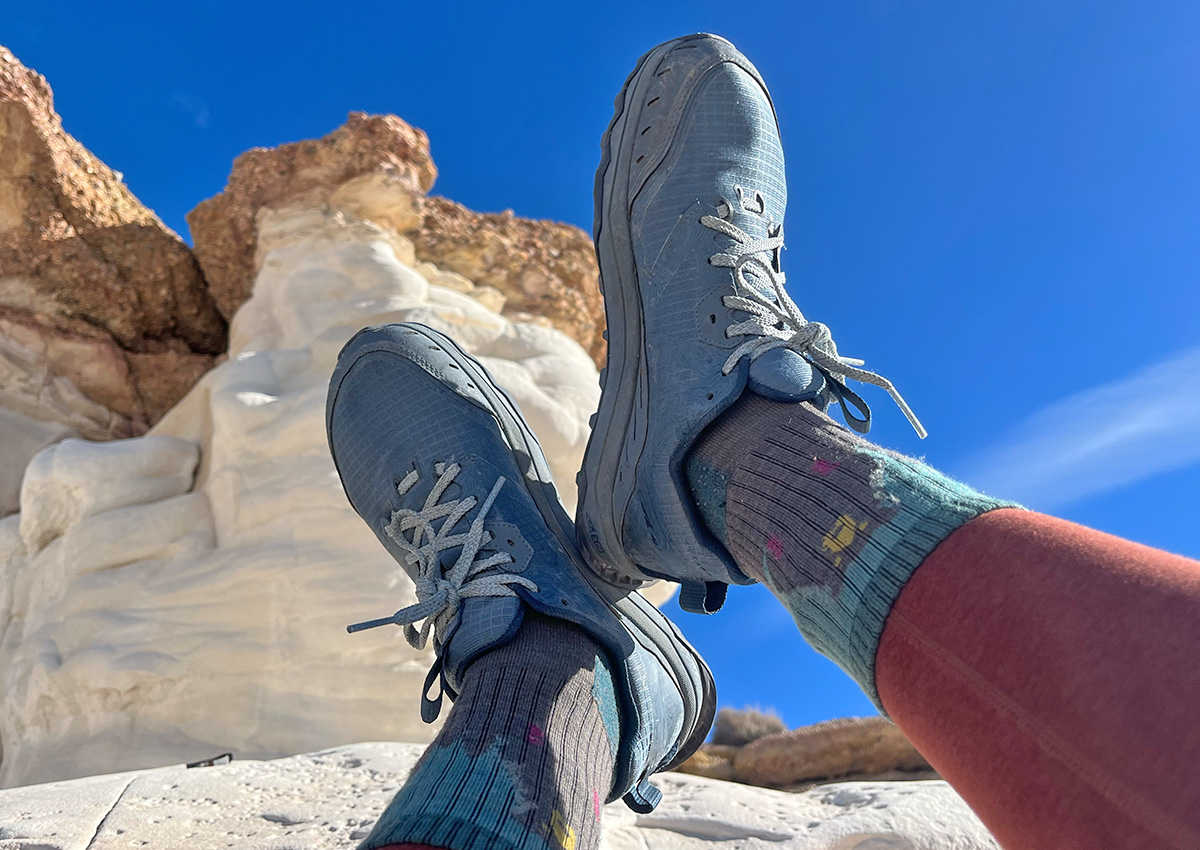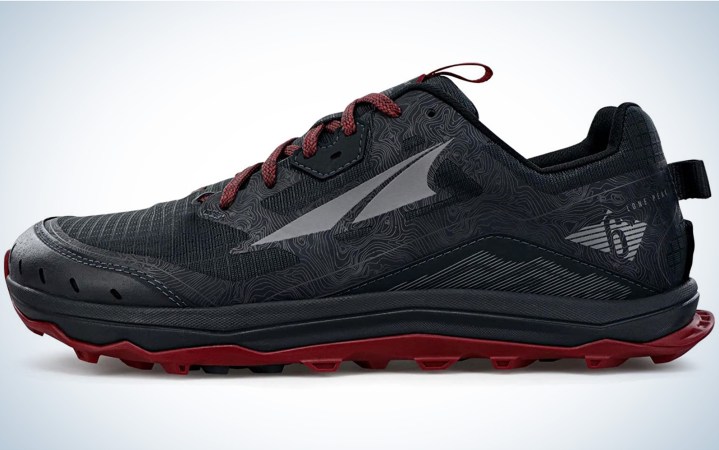We may earn revenue from the products available on this page and participate in affiliate programs. Learn More ›
Backpackers can be pretty fickle—always chasing new gear and new trends, in search of the next cottage company that can shave a few ounces off their base weight. But there is one piece of gear that has been a mainstay for years: the Altra Lone Peak trail runner. To say that backpackers like this shoe would be an understatement; they are obsessed with it. It’s consistently the most popular shoe for thru-hikers, and when the Colorado Mountain Club surveyed their members about the best hiking boot, the only clear winner was the Altra Lone Peak.
To find out whether this shoe lives up to the hype, the OL gear team each took a pair out on their daily rounds. We covered everything from trail running to off-trail hiking to hunting in environments ranging from the slickrock of the southwest to icy gravel roads in the upper midwest. Would we be converted?
Altra Lone Peak Specs and Features
- Men’s Sizes: 8 to 15
- Women’s Sizes: 5.5 to 12
- Available in wide
- Weight (pair): 22 ounces (men’s), 18.4 ounces (women’s
- Heel-Toe Drop: 0mm
- Stack Height: 25mm
- Midsole: Altra EGO foam
- Outsole: MaxTrac rubber
- Includes a rock plate
The Outdoor Life team tested the Altra Lone Peak 6; since then, the Altra Lone Peak 7 has been released, with some minor changes to the design. The changes between the 6 and 7 models include an upgraded sole, addition of a heel clip (to help lock in the heel), and no-sew uppers.
Zero Drop
If you’ve never heard of the Altra Lone Peak, there are a couple of important things to know about how this shoe differs from other trail runner brands. The first, and most important, is that it’s a zero-drop shoe.
Drop refers to the difference in the height between the front of the shoe and the back of the shoe. Traditionally, trail runners and hiking boots have had drops of about 10mm (a little less than half an inch), which helps to reduce the absorption of shock when you strike with your heel.
This can sometimes lead to a chicken and egg problem: Do runners need extra cushion because they are landing on their heels? Or are they landing on their heels because there is extra cushion? The Lone Peak does away with this conundrum by eliminating the heel drop entirely. The cushion at the front of the shoe is the same as at the heel of the shoe.
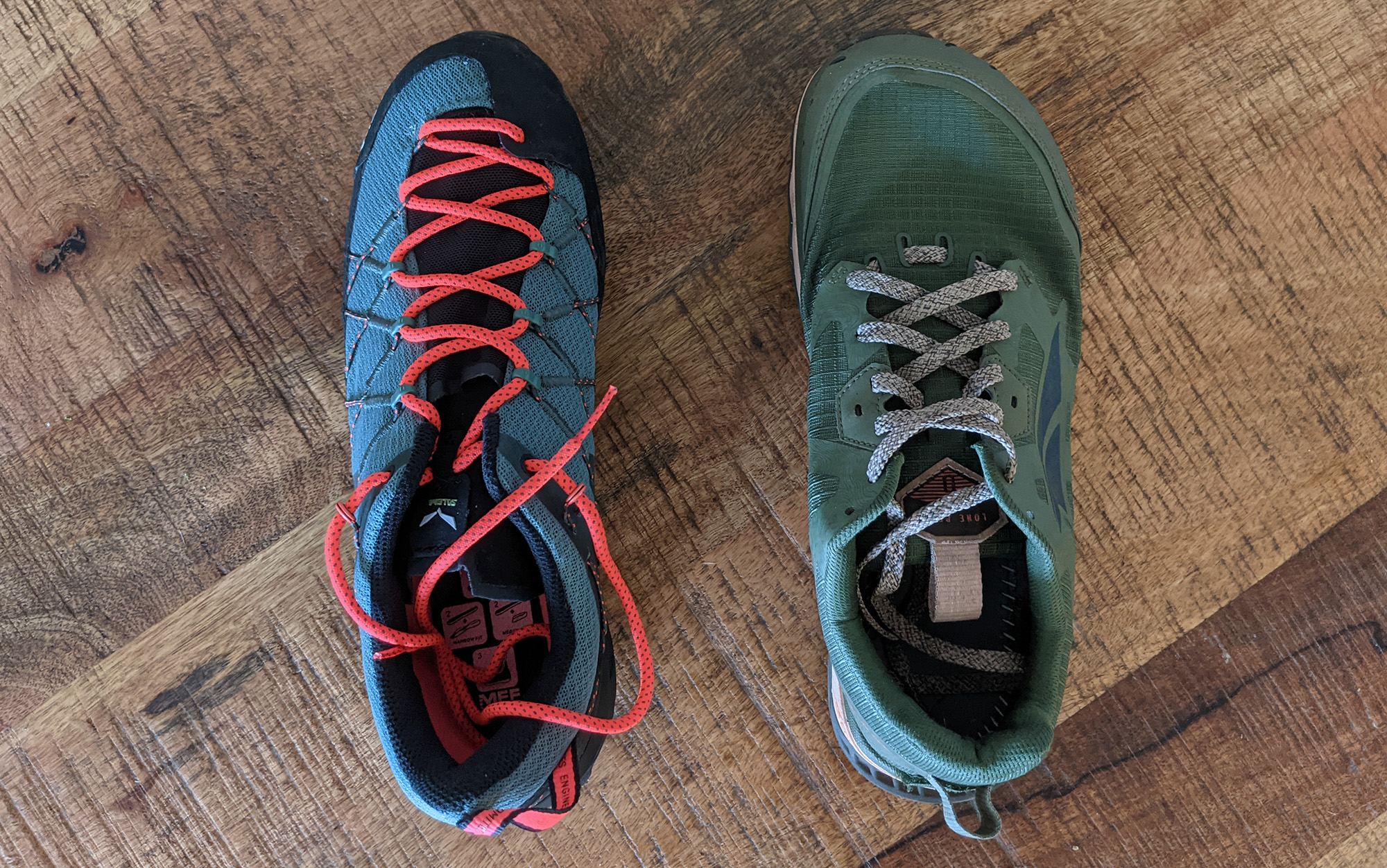
Wide Toe Box
The next difference with the Altra Lone Peak is the toe box. Most shoes—including, running, hiking, everyday—widen around the ball of the foot and then narrow at the toe box. This helps to promote a locked-in feeling for some runners, but it also prevents your toes from splaying naturally, as they would if you were running barefoot.
If you want to see this in action, just try running across a grassy field without any shoes or socks on. By widening the toe box, the Altra Lone Peaks give you some of the advantages of barefoot-style running, theoretically increasing your stability and reducing the risk of foot-related pain like plantar fasciitis. This design choice has been picking up in popularity, and several brands, including Hoka and Topo, have either increased the width of their shoe in more recent models or adopted this style outright since the Altra Lone Peak first arrived on the scene.
Read Next: Best Hiking Shoes for Men
Testing the Lone Peaks in the Field
The four Outdoor Life staff that tested the Lone Peaks live in different regions with different body types as well as different running gaits and shoe preferences. I’ve broken the review down by running/hiking style—and included their current shoe of choice—so that you can find the person you most closely identify with and see what they thought.
If you identify as a heel striker, then Alex Robinson’s take is worth looking at, while midfoot and forefoot strikers should check out Scott Einsmann’s experience. If you prefer a supportive shoe, then look at Ashley Thess’s take (as well as her current shoe of choice), while if you prefer a more minimalist or barefoot shoe, then start with Laura Lancaster’s.
Alex Robinson, Editor in Chief
Go-to shoe: HOKA Speedgoat 5
Alex describes his shoe preferences as “maximalist,” and it shows in his choice of footwear. Hoka’s trail running shoes are known for their cushiony midsole—some of their models look like moon boots to the uninitiated—a contrast with the rock plate-protection of the Altra Lone Peaks. But the stack height of the Speedgoat versus the Lone Peak wasn’t all that different: 29mm at the forefoot versus 25mm.
Alex took the Lone Peaks out for a series of shoulder-season gravel runs near his home in Minnesota and was initially impressed by their traction in snowy and icy conditions, noting that “with more waterproofing these would be an excellent winter running shoe.” (Good news: Altra does indeed make an all-weather version of the Lone Peaks.) But after running 40 miles over three runs, he was experiencing more soreness in his legs and knees than he was accustomed to. One likely cause of this was the comparative lack of cushion at the heel of the Lone Peaks. Because while Alex noted that the zero-drop meant he did strike with his fore-foot more in the Lone Peaks than in his typical running shoe, he was still primarily striking with his heel. When you strike with your heel, more of the shock of the impact is absorbed through your knee, as opposed to forefoot striking, which puts more load on your Achilles. And while the stack height at the forefoot of the Speedgoat was comparable to the Lone Peak, the Hoka Speedgoat had 8 mm more cushion at the heel.
Verdict: The zero-drop style did not convert this dedicated heel striker, but he still plans to use these shoes for casual hikes and around camp.
Laura Lancaster, Staff Writer
Go-to shoe: Vivobarefoot Primus FG
If Alex is the maximalist of the group, then I’m the minimalist. I’ve been running in barefoot shoes since Born to Run was in hardback. Like most barefoot shoe enthusiasts, I’m constantly on the lookout for the best minimalist shoe for hiking and trail running, in part because there are so few companies that make them. But read enough posts on r/Barefoot and you’ll find the Altra Lone Peaks coming up again and again as a suggestion (the toe box! the zero drop!) followed by a string of replies complaining about the stack height, which refers to the height of the material underneath the sole of your foot. So I was curious to see: Were the Lone Peaks worthy of being called a minimalist shoe?
I took my pair of Altras with me to Montana for a press trip testing out the new OnX Backcountry app. The plan was to try out the app on both existing trails and on an off-trail route that our guide had scouted out the week prior.
First up was the existing trail, a well-maintained rocky trail in the Beartooths. My initial impression of the Altra Lone Peaks was positive. The wide toe box meant I had all the stability I was used to, and the 0 heel drop and nearly non-existent arch support meant my typical mid-foot strike while hiking stayed the same. If anything, I ended up spending less time looking at the ground than usual, since the 25mm stack height and rock plate kept me from feeling any pieces of sharp rock poking up out of the ground. So far, so good.
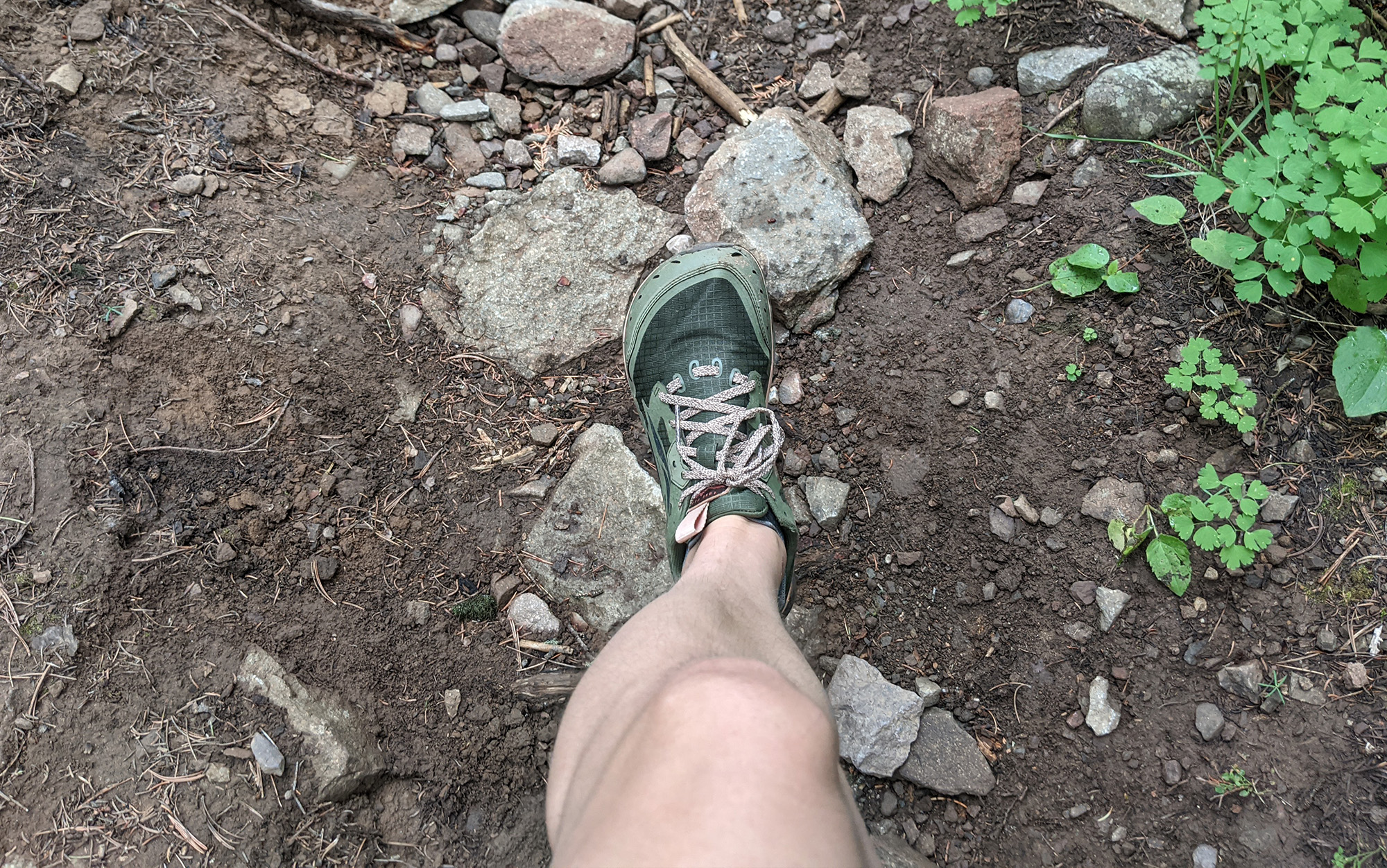
When we got in sight of a lake, the group decided to hoof it off trail for a quarter of a mile or so to the shore. This is when things started to go south for me. As I scrambled over downed trees, stepping on the occasional insecure boulder in between thick grass that hid the ground, I started to notice how much the increased stack height was impacting my spatial awareness, and my stability as a result. In my typical shoes—the Vivobarefoot Primus FG—I always know where the bottom of my shoe is because, with a stack height of 6.5mm, it’s basically where the bottom of my foot is. The stack height of the Lone Peaks is almost four times that. With every step I was internally calculating where to step, how to step, and bracing myself against losing my balance and rolling an ankle. (It’s practically impossible to roll your ankle in a true minimalist shoe.) I switched back to my regular shoes before the next day’s cross-country rock scramble.
Verdict: These would be a great shoe for someone curious about transitioning to minimalist footwear, but barefoot-style runners accustomed to a low stack height should steer clear.
Ashley Thess, Assistant Editor
Go-to shoe: Topo Ultraventure 2
At first glance, Ashley’s current shoe of choice, the Topo Ultraventure 2, looks fairly similar to the Altra Lone Peaks. Both have wide, roomy toe boxes, both have 25mm of drop at the front of the shoe (like the Hoka Speedgoats, these also have an extra 5mm at the heel). But she found that the shoes didn’t provide the level of support that she needed for her self-described trail running style of “hiking up and then running down at variable speeds, usually bouncing off the sides.”
One difference between the Altra Lone Peaks and the Topo Ultraventure, as well as most traditional running and hiking shoes, is the level of arch support provided by the shoe. The Lone Peaks have fairly minimal arch support (I barely noticed it despite exclusively wearing shoes with no arch support), so that the foot can move naturally. While this is what Ashley experienced—she described the barefoot feel as giving her a sense of “wild, child-like abandon” while running—it also resulted in shin splints. Further, Ashley found that for her feet, the greater interior volume of the Altra Lone Peaks ended up being too roomy, and she didn’t have the locked-in feeling that she looks for while adventuring.
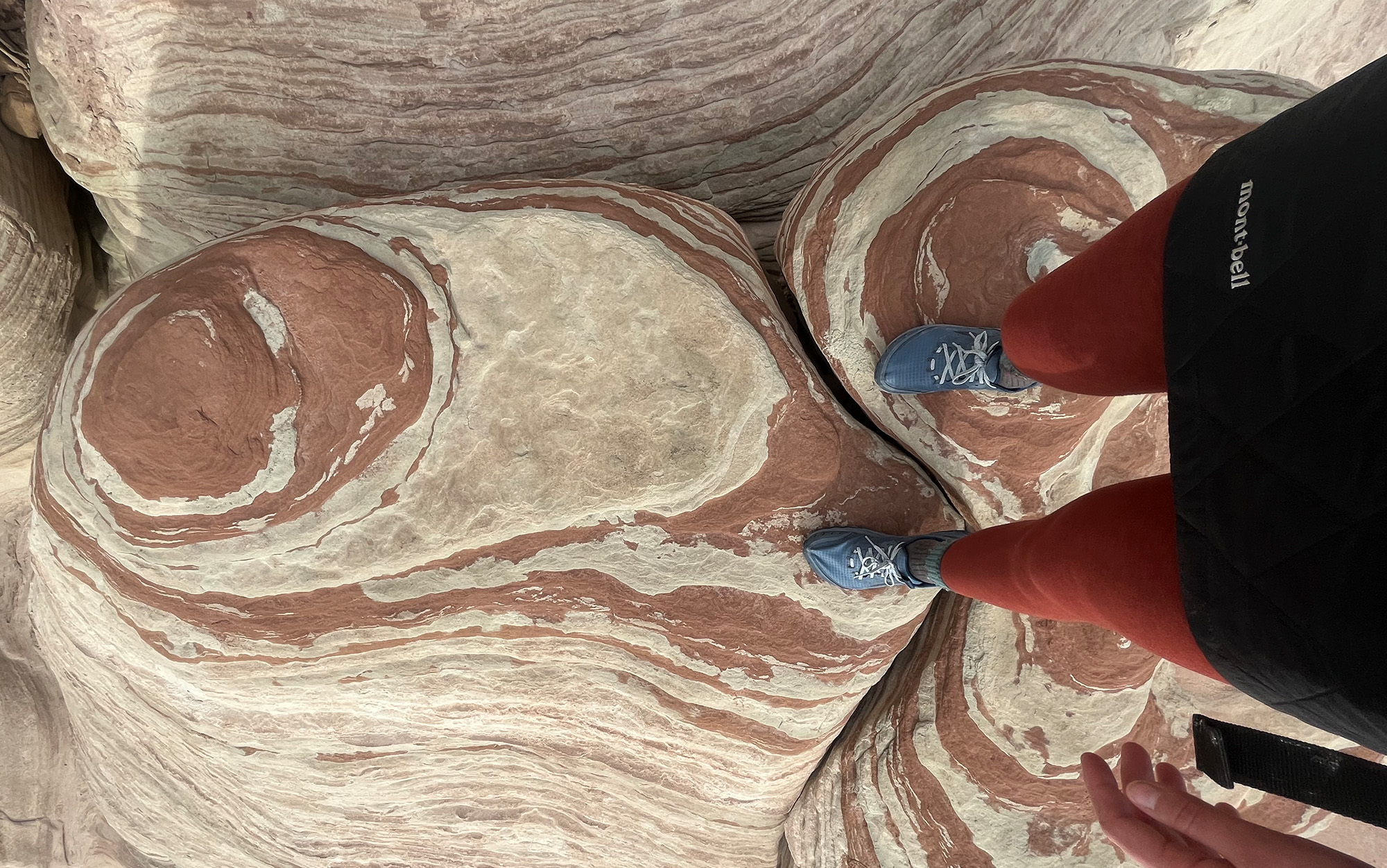
Other details of the Altra Lone Peaks also ended up being hit or miss for her environment. The fine dust and sand of the southwest got inside this shoe faster than others she’s tried. And while she echoed Alex’s experience of the Lone Peaks having enough traction to handle some ice, she found that they didn’t provide enough grip for slickrock.
Verdict: The roomy, minimalist interior wasn’t a match for Ashley’s foot shape or running style, but their overall comfort has made them her go-to pick for day-to-day errands.
Scott Einsmann, Gear Editor
Previous go-to shoe: Salomon XA Pro 3D
“These Altras are money,” Scott told me the day his Lone Peaks showed up. “It feels like I’m not wearing shoes but have the protection and support of a shoe.” Of the four members of the gear team, Scott had by far the most positive experience, ultimately covering over 150 miles in the Altra Lone Peaks over four months and using them for everything from running to hunting to archery competitions. He ended up liking these shoes enough that he permanently switched his go-to shoe from the Salomon XA Pro 3D to the Altra Lone Peak.
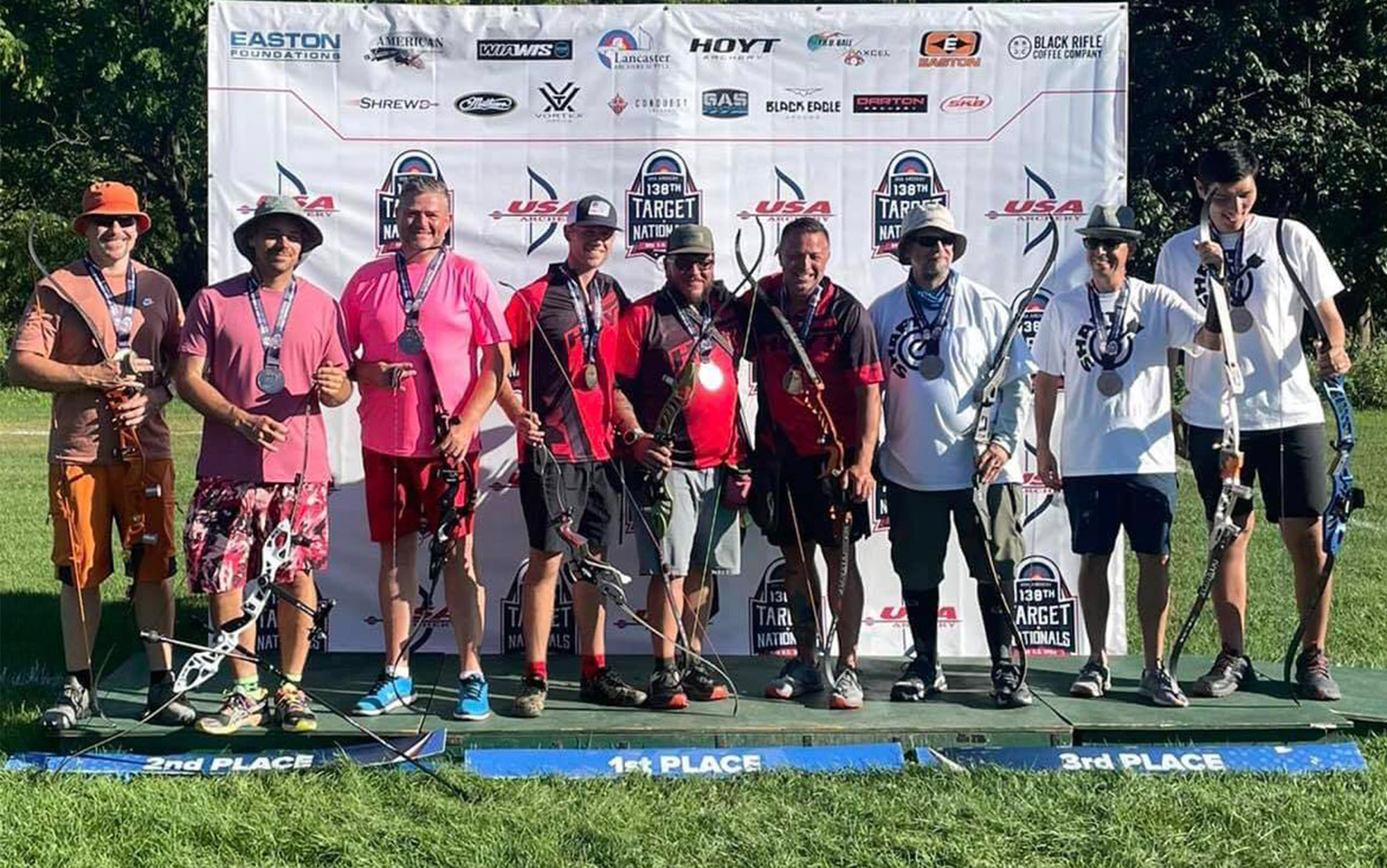
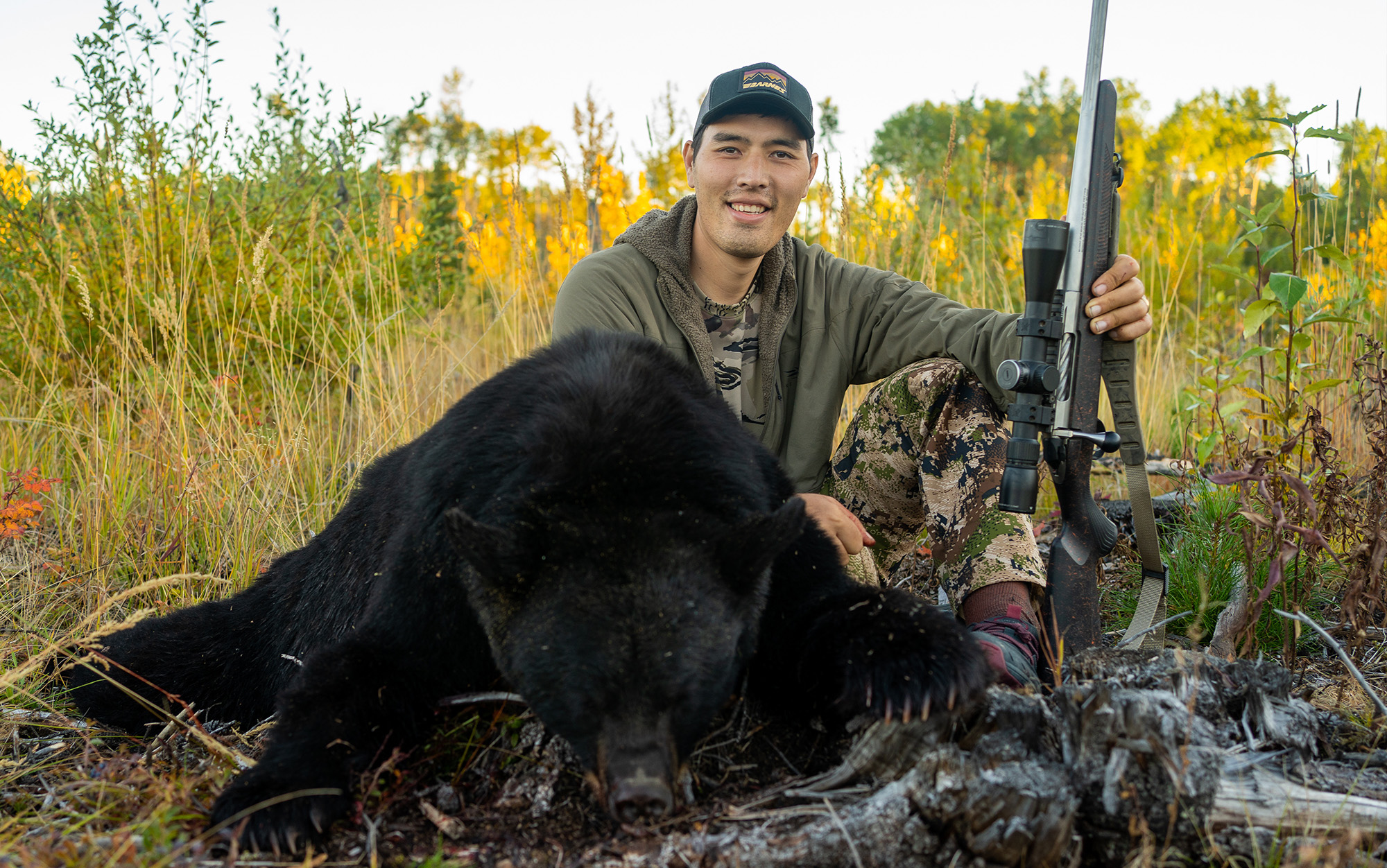
Something that stood out to Scott while running—training for an upcoming elk hunt—was that not only did his knees hurt less than he was used to, but his posture was also better than when he ran in his Salomon XA Pro 3D. Those shoes have a heel drop of 11mm, plenty of extra padding for heel strikes, but it can interfere with the natural gait of those prone toward mid-foot or forefoot striking. Despite this larger heel drop, Scott was running with a mid-foot strike in the Salomons—in the Altras, he now tends toward a forefoot strike. He also noted, The zero drop is ideal for archery competitions because it promotes good balance.”
For Scott, another advantage of the Altra Lone Peaks was the wide toe box. Traditional-style running shoes, like the Salomon XA Pro 3D—tend to narrow at the toes, locking them into place while you run. While for some runners, this locked-in feel translates as stability, others find that the ability to splay their toes improves their balance, and gives them better stability on uneven ground.
What the Altra Lone Peaks Do Best
These are some of the few true zero-drop shoes on the market that also provide a level of underfoot cushioning. Midfoot and forefoot strikers dissatisfied with their current footwear should put the Altra Lone Peaks on their shortlist of shoes to try out for that reason alone. Similarly the wide toebox helps to improve stability while hiking, especially over uneven terrain. Finally, individuals looking to ease their way into true minimalist footwear should consider this as an in-between shoe that will allow their foot (particularly their arch) to strengthen after years of wearing more traditionally supportive shoes.
What the Altra Lone Peaks Do Worst
While the wide toe box does add stability for most runners and hikers, this is not an especially supportive shoe. The shape of the shoe did not lock our tester’s feet into position as well as others they’ve tried, and the lack of internal structure was seen as an issue by several (although adding an insole like Superfeet can help to alleviate this issue). It also does not keep out dust or sand as well as other trail runners out there.
Final Thoughts
If you’re looking to switch up your footwear, whether it be for hiking, trail running, or hunting, then it’s worth putting the Altra Lone Peaks onto your short list. While some heel strikers will find the comparative lack of cushion and zero drop a no-go, other runners may discover that they naturally change their gait in footwear that promotes a mid-foot or forefoot strike, with subsequent benefits in their running form, knee pain, or both. One thing to note is that there is minimal support, particularly arch support in this shoe, so some runners may need to add in a custom insole, such as from Superfeet, to compensate.
